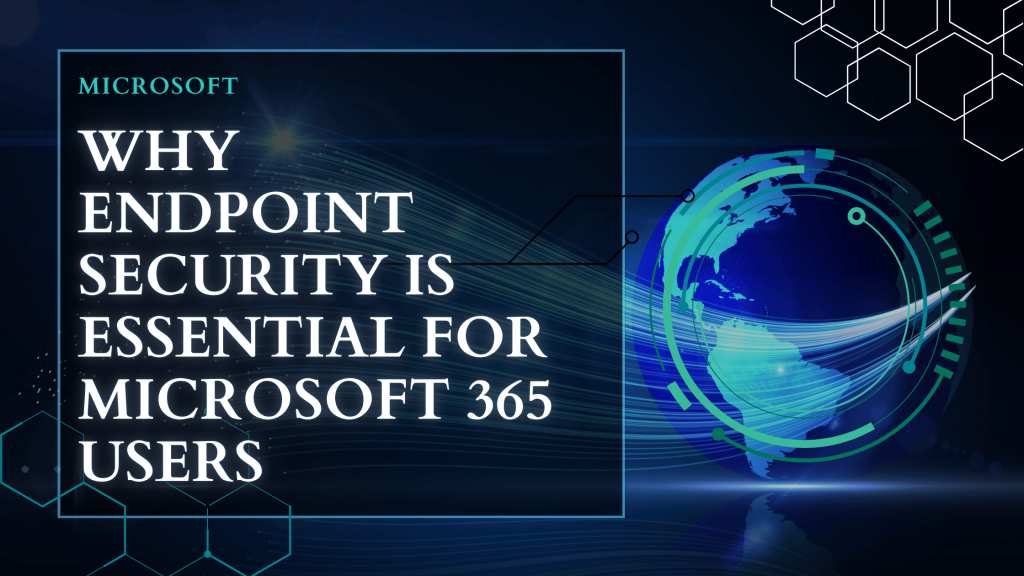The cyber world and business are increasingly reliant on cloud-based platforms like Microsoft 365 for collaboration, communication, and productivity and with this worldwide use comes a growing risk of cyber threats targeting the endpoints used to access these platforms. Endpoint security is key in protecting Microsoft 365 environments, and this blog will explore why businesses should prioritise securing their endpoints to safeguard sensitive data and make sure their operations run smoothly.
Endpoint Security
Endpoint security refers to the practice of securing the devices (endpoints) that connect to a network, such as computers, smartphones, tablets, and other IoT devices. These endpoints serve as the entry points for cybercriminals who aim to exploit vulnerabilities and gain access to an organisation’s sensitive data. Given that these endpoints interact with cloud-based services like Microsoft 365, securing them is especially important to protecting the organisation’s network and data.

Importance of Endpoint Security in Business
The importance of endpoint security cannot be overstated, especially as businesses embrace remote work and mobile devices become quite common. Endpoint vulnerabilities are prime targets for cybercriminals, as compromised endpoints can lead to breaches that expose sensitive information and cause significant financial damage. Microsoft 365, with its cloud-driven services such as OneDrive, SharePoint, Teams, and Outlook, is a prime target for these attacks.
In fact, Microsoft 365 is often considered a top target because of its worldwide adoption, the large amount of valuable data it houses, and its integration with multiple devices. Hackers can use compromised endpoints to get access to corporate emails, documents, and communications, and increasing their chances of disrupting operations or even stealing intellectual property.
Common Threats That Target Endpoints in Business
- Malware
Malware is bad software that can infect endpoints through downloads, email attachments, or compromised websites. Once the malware is installed, it can steal sensitive data, encrypt files, or give attackers remote access to the device. For example, a simple click on a malicious link or downloading an infected file can discharge a series of attacks on an endpoint, which then compromises the entire Microsoft 365 environment. - Phishing
Phishing attacks involve cybercriminals sending emails that are disguised as normal emails but are not and that are from trusted sources (such as internal company emails or familiar service providers) to trick users into revealing their login details. Microsoft 365 is often targeted by phishing attempts because of its rampancy in the business world. Successful phishing attacks can provide hackers with access to users’ Microsoft 365 accounts, allowing them to steal data or infiltrate the organisation’s systems. - Ransomware
Ransomware attacks and locks users out of their files or systems until a ransom is paid. A successful ransomware attack on an endpoint could encrypt key components of the business, files stored in Microsoft 365 apps, disrupting operations and potentially leading to big financial losses. Cybercriminals normally use phishing emails or malicious links to install ransomware on an endpoint, where it spreads quickly and locks down sensitive data.
Real-World Case Studies of Cyberattacks Targeting Endpoints
To highlight the real-world consequences of poor endpoint security, consider the following cases:
- The 2020 Twitter Hack: In this high-profile case, hackers gained access to Twitter employee accounts through a spear-phishing attack, gaining control over verified accounts like Elon Musk’s and Barack Obama’s. While this was not related to Microsoft 365, it highlights how attackers can manipulate endpoints and compromise organisational networks by exploiting weaknesses in user behaviour and endpoint security.
- The 2017 WannaCry Ransomware Attack: This attack was one of the biggest ransomware incidents, exploiting vulnerabilities in unpatched Windows endpoints to spread rapidly. While WannaCry primarily targeted businesses and government agencies that did not apply security patches, it serves as a stark reminder that endpoint security, including regular software updates, important to protecting against worldwide malware attacks.
- Phishing Campaigns Against Office 365 Users: In 2020, the hackers targeted Office 365 users with phishing emails that appeared to come from legitimate sources within the organisation. These emails tricked employees into entering their login details, giving hackers access to email systems, which they used to launch further phishing attacks and spread malware.
Why Endpoint Security is Non-Negotiable in a Microsoft 365 Environment
Given the range of threats targeting endpoints and the increasing dependence on Microsoft 365 for business operations, securing these endpoints is essential for businesses. A breach at the endpoint level can provide attackers with access to entire company networks, including sensitive data stored in SharePoint, OneDrive, and Teams, potentially leading to great financial losses, reputation damage, or compliance violations.
Microsoft 365 itself offers robust security features like multi-factor authentication (MFA), data loss prevention (DLP), and encryption. However, without securing the devices that access these services, these protections can be easily bypassed. For example, if an employee’s laptop is compromised, an attacker could bypass MFA or exploit weak password policies to access sensitive business resources.
How to Effectively Secure Your Endpoints
Securing endpoints is a proceeding process that requires multiple layers of defence. Here are some best practices businesses should follow to safeguard their Microsoft 365 environment:
- Implement Endpoint Detection & Response (EDR)
Endpoint Detection & Response (EDR) solutions provide real-time monitoring of endpoints, allowing businesses to detect, investigate, and respond to suspicious activity. By deploying EDR tools, businesses can quickly find threats and mitigate risks before they escalate into full-fledged security incidents. - Enforce Strong Authentication Policies
Enforcing strong authentication methods such as multi-factor authentication (MFA) helps protect endpoints from unauthorised access. Even if an attacker compromises an endpoint, MFA provides an added layer of defence to prevent them from accessing critical resources in Microsoft 365. - Regular Software Updates and Patching
Keeping endpoint devices up to date with the latest security patches is vital in preventing attackers from exploiting known vulnerabilities. Ensuring that all endpoints are regularly updated can significantly reduce the risk of malware infections and other cyberattacks. - User Training and Awareness
Employees are often the weakest link in cybersecurity. Phishing and social engineering attacks rely on human error to succeed. Providing regular security training and promoting awareness about common threats, such as phishing fraud, can significantly reduce the likelihood of successful attacks. - Implement Endpoint Encryption
Encrypting endpoint devices ensures that if they are lost or stolen, sensitive data stays protected. This is particularly important for businesses that rely on remote work or allow employees to use personal devices to access Microsoft 365. - Monitor and Enforce Security Policies
Regularly checking endpoint activity and enforcing security policies across devices is key to finding risks and keeping a secure environment. This includes controlling access to sensitive data, restricting the use of unauthorised software, and monitoring employee behaviour for any signs of potential threats.
As we lean increasingly on cloud platforms like Microsoft 365, protecting our endpoints is just essential. Cyberattacks are a serious threat. By implementing a solid endpoint security strategy, you can protect your Microsoft 365 environment, safeguard your data, and minimise your risks. It is about putting the right tools and practices in place to keep your endpoints secure and your data safe. And honestly, isn’t that worth it?
Ready to take the next step? Book a free call and let’s talk about how we can help you grow.




